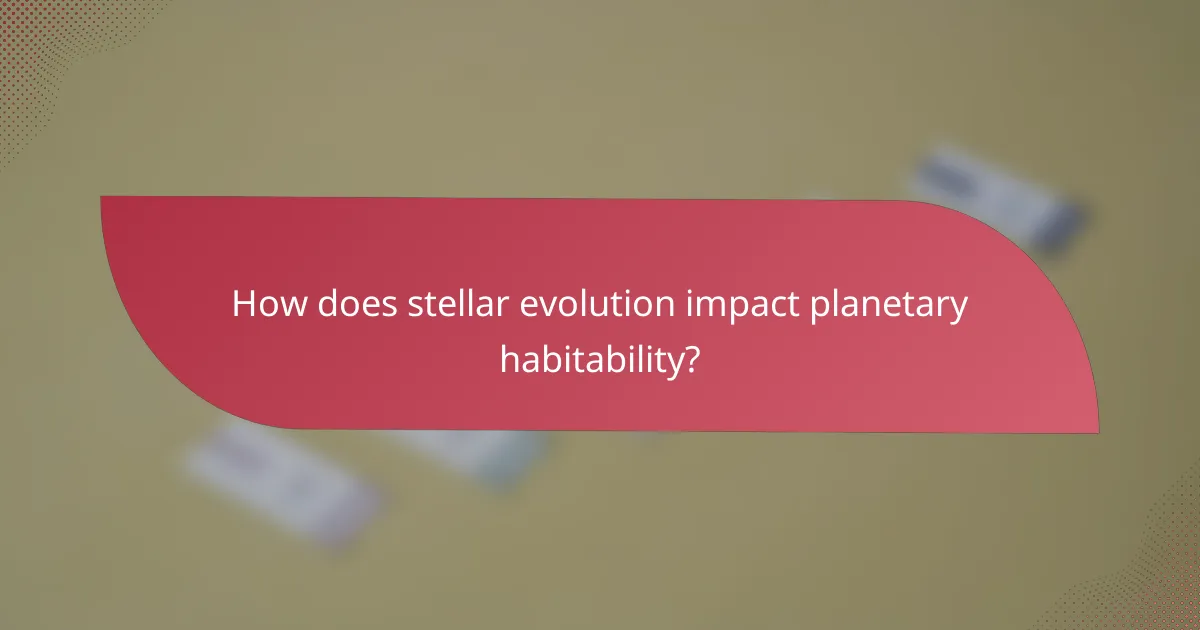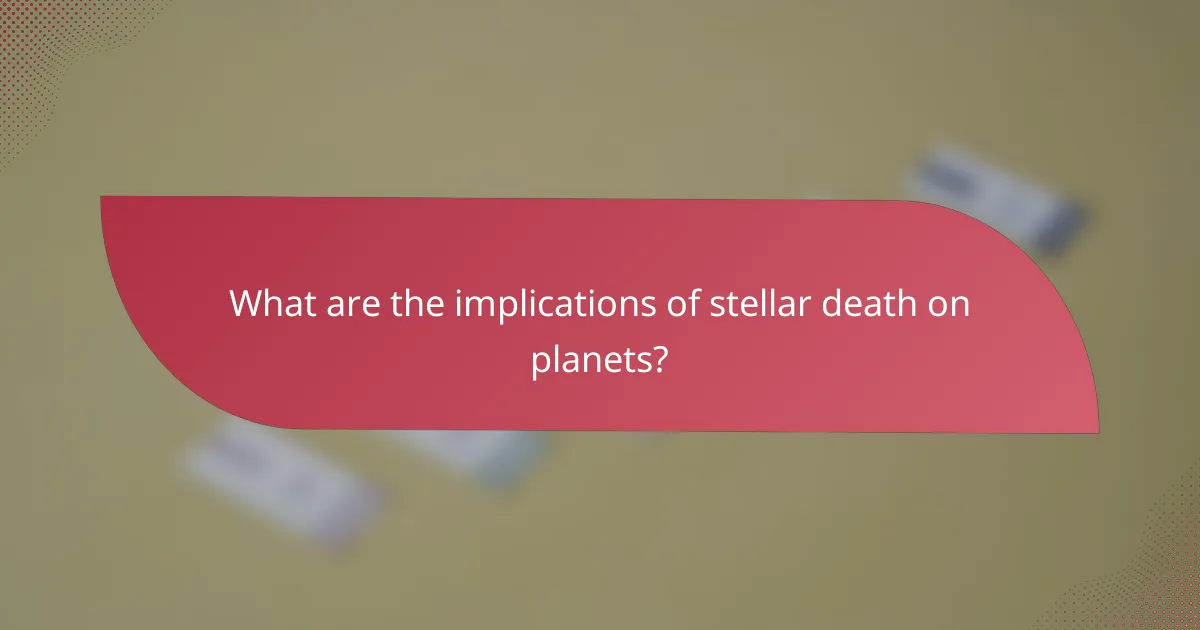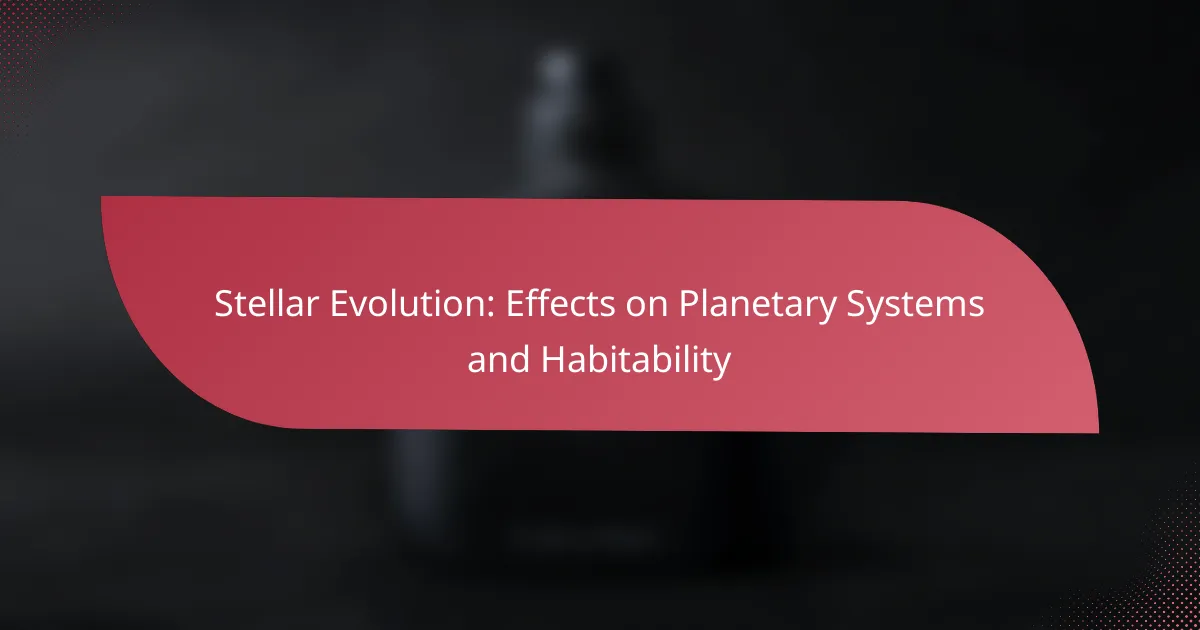Stellar evolution plays a crucial role in shaping the habitability of planetary systems by modifying the environmental conditions essential for life. As stars progress through their life cycles, changes in energy output and radiation levels can profoundly impact the stability and characteristics of the planets orbiting them, ultimately influencing their potential to support life.

How does stellar evolution impact planetary habitability?
Stellar evolution significantly influences planetary habitability by altering the conditions necessary for life. As stars age, they undergo changes that affect their energy output, radiation levels, and the stability of their planetary systems.
Effects on atmospheric composition
The evolution of a star can lead to changes in the atmospheric composition of its orbiting planets. For instance, as a star transitions from the main sequence to the red giant phase, it may emit increased ultraviolet radiation, potentially stripping away lighter atmospheric gases and altering the balance of heavier elements.
This shift can result in a less hospitable environment. Planets may lose essential gases like water vapor or carbon dioxide, which are crucial for maintaining life-supporting conditions.
Influence on climate stability
Stellar evolution affects the climate stability of planets by changing the amount of energy they receive. For example, as a star evolves and expands, it may increase the average temperature of its planets, leading to runaway greenhouse effects or other extreme climate changes.
Such fluctuations can disrupt long-term climate patterns, making it difficult for life to adapt. A stable climate is essential for the development and sustainability of ecosystems, so significant changes can be detrimental.
Potential for life development
The potential for life development is closely tied to the evolutionary stage of a star. During the stable main sequence phase, stars provide a consistent energy output, which is conducive to the emergence of life. However, as stars evolve, the likelihood of extreme conditions increases, which can hinder or even eliminate the chances for life to thrive.
For example, planets around a dying star may experience harsh radiation and temperature fluctuations that make it nearly impossible for life to survive. Understanding these evolutionary stages can help scientists identify which exoplanets might be more likely to host life.

What are the stages of stellar evolution?
The stages of stellar evolution outline the life cycle of stars, from their formation to their eventual demise. This process significantly influences planetary systems and their potential for habitability.
Formation of main sequence stars
Main sequence stars form from clouds of gas and dust, undergoing gravitational collapse that leads to nuclear fusion in their cores. This phase is characterized by a stable balance between the outward pressure from fusion and the inward pull of gravity.
Main sequence stars can vary in size and temperature, with larger stars burning hotter and faster, often lasting only a few million years, while smaller stars may exist for tens of billions of years. The most common type of main sequence star is the G-type star, like our Sun.
Red giant phase characteristics
The red giant phase can last for several hundred million years, during which the outer layers may be ejected, forming planetary nebulae. This phase is critical for the distribution of heavy elements, which can enrich surrounding planetary systems.
Supernova and its aftermath

How do different star types affect planetary systems?
Different star types significantly influence the characteristics and stability of their surrounding planetary systems. Factors such as the star’s mass, temperature, and lifespan play crucial roles in determining the potential habitability of planets orbiting them.
Impact of massive stars on nearby planets
Massive stars, typically those with more than eight times the mass of the Sun, have short lifespans, often only a few million years. Their intense radiation and stellar winds can strip away the atmospheres of nearby planets, making it difficult for them to retain water and support life. Additionally, the supernova explosions at the end of their life cycles can disrupt or destroy nearby planetary systems.
For example, a planet orbiting a massive star may experience extreme conditions that could lead to a barren landscape, devoid of the necessary elements for life. The rapid evolution of such stars means that any potential for habitability is often short-lived.
Role of red dwarfs in habitability
Red dwarfs, the smallest and coolest type of star, have lifespans that can extend to tens of billions of years, providing a stable environment for orbiting planets. Their lower luminosity means that planets must be closer to the star to maintain liquid water, often placing them in the habitable zone. This proximity can lead to tidal locking, where one side of the planet always faces the star, creating extreme temperature differences.
Despite these challenges, red dwarfs are considered promising candidates for hosting habitable planets. The long stability of red dwarfs allows for extended periods of biological evolution, increasing the chances of life developing under the right conditions.
Comparative analysis of star types
When comparing different star types, it is essential to consider their mass, temperature, and lifespan. For instance, while massive stars can create heavy elements through fusion, their short lifespans limit the time available for life to develop. In contrast, red dwarfs offer longevity but may present challenges such as tidal locking and limited habitable zones.
Here’s a brief comparison of key star types:
| Star Type | Lifespan | Temperature | Impact on Habitability |
|---|---|---|---|
| Massive Stars | Millions of years | High | Destructive to nearby planets |
| Sun-like Stars | Billions of years | Medium | Stable, potential for habitability |
| Red Dwarfs | Tens of billions of years | Low | Long-term stability, challenges in habitability |
This comparative analysis highlights the diverse impacts different star types have on the potential for life in their planetary systems.

What are the implications of stellar death on planets?
The death of a star can significantly impact surrounding planets, potentially altering their atmospheres, orbits, and overall habitability. Events such as supernovae and the formation of planetary nebulae can lead to both destruction and the creation of new conditions for life.
Formation of planetary nebulae
When a star like our Sun exhausts its nuclear fuel, it sheds its outer layers, creating a planetary nebula. This process enriches the surrounding interstellar medium with heavy elements, which can contribute to the formation of new stars and planets.
Planetary nebulae can last for thousands to tens of thousands of years, providing a fertile environment for the next generation of celestial bodies. The materials released during this phase can potentially lead to the development of habitable zones around new stars.
Effects of supernova explosions
A supernova occurs when a massive star explodes at the end of its life cycle, releasing an immense amount of energy and radiation. This explosion can obliterate nearby planets, stripping away atmospheres and altering orbits due to the shockwave produced.
However, supernovae also play a crucial role in the cosmic ecosystem. The explosion disperses heavy elements, which are essential for forming rocky planets and potentially supporting life. The radiation from a supernova can also trigger star formation in nearby gas clouds, leading to new planetary systems.
Long-term impacts on surrounding systems
The aftermath of stellar death can reshape the dynamics of surrounding planetary systems. For instance, the gravitational influence of a remnant neutron star or black hole can alter the orbits of nearby planets, potentially making them more or less habitable.
Over time, the materials from stellar explosions contribute to the galactic chemical enrichment, influencing the composition of future stars and planets. This ongoing cycle of stellar evolution ensures that the universe remains dynamic, with new opportunities for habitability arising from the remnants of past stars.

How can we assess habitability in exoplanetary systems?
Assessing habitability in exoplanetary systems involves evaluating various factors that indicate whether a planet can support life. Key considerations include the planet’s location in relation to its star, atmospheric composition, and surface conditions.
Criteria for evaluating exoplanet habitability
Several criteria are essential for determining the habitability of exoplanets. These include the presence of liquid water, a stable climate, and an atmosphere that can protect against harmful radiation. Additionally, the planet’s geological activity can influence its ability to sustain life.
Researchers often use the Earth Similarity Index (ESI) to quantify how closely an exoplanet resembles Earth in terms of size, temperature, and other factors. A higher ESI indicates a greater potential for habitability.
Role of the habitable zone
The habitable zone, often referred to as the “Goldilocks zone,” is the region around a star where conditions may be just right for liquid water to exist. This zone varies depending on the star’s size and temperature, with smaller, cooler stars having closer habitable zones compared to larger, hotter stars.
Planets within this zone are more likely to maintain temperatures conducive to life. However, being in the habitable zone does not guarantee habitability, as other factors like atmospheric pressure and composition also play critical roles.
Technological advancements in detection
Recent technological advancements have significantly improved our ability to detect and assess exoplanets. Space telescopes like the Transiting Exoplanet Survey Satellite (TESS) and the James Webb Space Telescope (JWST) are equipped to identify exoplanets and analyze their atmospheres.
These tools allow scientists to gather data on atmospheric gases, surface temperatures, and potential biosignatures, enhancing our understanding of which exoplanets might be habitable. Continuous improvements in detection methods will likely lead to more discoveries in the coming years.

What future trends in stellar evolution research are emerging?
Future trends in stellar evolution research are increasingly focused on advanced modeling techniques and interdisciplinary approaches. These developments aim to enhance our understanding of how stars evolve and influence their surrounding planetary systems and potential habitability.
New methods in astrophysical modeling
New methods in astrophysical modeling are revolutionizing how researchers simulate stellar processes. Techniques such as machine learning and high-performance computing allow for more complex and accurate models of stellar evolution, enabling scientists to predict the life cycles of stars with greater precision.
For instance, machine learning algorithms can analyze vast datasets from telescopes and simulations to identify patterns in stellar behavior that were previously unnoticed. This can lead to improved predictions about phenomena like supernovae and their impact on nearby planetary systems.
Moreover, integrating data from various disciplines, such as chemistry and planetary science, enhances the models’ realism. Researchers can better assess how stellar evolution affects planetary atmospheres and potential habitability, providing insights into the conditions necessary for life beyond Earth.


